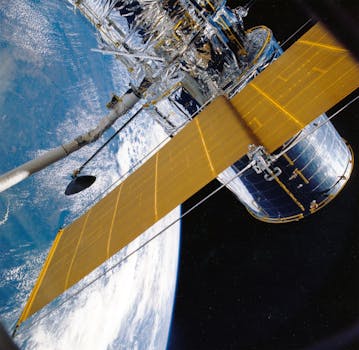
The Future is Now: Exploring the Cutting-Edge Innovations in Satellite Telecommunications
Satellite Telecommunications is experiencing a significant transformation, driven by cutting-edge innovations that are revolutionizing the way we communicate globally. The future of telecommunications is now, and it’s more exciting than ever. With the increasing demand for high-speed internet, mobile connectivity, and reliable communication services, the satellite industry is rising to the challenge, leveraging advancements in technology to provide faster, more efficient, and more accessible services.
The integration of satellite telecommunications with other technologies such as 5G, artificial intelligence, and the Internet of Things (IoT) is creating new opportunities for growth and development. One of the key innovations in satellite telecommunications is the development of low-Earth orbit (LEO) satellites. These satellites orbit the Earth at an altitude of around 1,200 kilometers, providing lower latency and higher bandwidth than traditional geostationary satellites. Companies such as SpaceX, OneWeb, and Amazon’s Kuiper Systems are leading the charge in this area, with plans to launch thousands of LEO satellites in the coming years.
Another significant advancement in satellite telecommunications is the use of phased array technology. This technology allows for the creation of highly directional and steerable beams, enabling satellites to communicate with multiple users simultaneously and providing more efficient use of bandwidth. Phased array technology is also being used to develop flat-panel antennas, which are lighter, more compact, and more cost-effective than traditional parabolic antennas.
Advances in Satellite Technology
In recent years, there have been significant advances in satellite technology, driven by improvements in materials, manufacturing processes, and design techniques. One of the key areas of development is in the field of propulsion systems, where new technologies such as electric propulsion and advanced ion engines are being used to increase the efficiency and lifespan of satellites. Additionally, the use of 3D printing and other advanced manufacturing techniques is enabling the creation of complex satellite components, such as antennas and optical systems, with greater precision and speed.
The development of satellite constellations is another area of innovation, where multiple satellites are launched and operated together to provide global coverage and continuous service. These constellations are being used for a range of applications, including Earth observation, navigation, and communication. The use of satellite constellations is also enabling the creation of new services, such as satellite-based Internet of Things (IoT) networks and satellite-enabled 5G networks.
Applications and Services
The cutting-edge innovations in satellite telecommunications are enabling a range of new applications and services, from broadband internet and mobile connectivity to Earth observation and navigation. One of the key areas of growth is in the field of satellite-based broadband, where companies such as Hughes Network Systems and Viasat are providing high-speed internet services to consumers and businesses in remote and underserved areas. Satellite-based broadband is also being used to support the development of smart cities and communities, where high-speed internet is essential for the delivery of services such as public safety, transportation, and healthcare.
Satellite telecommunications is also playing a critical role in the development of 5G networks, where the use of satellite-based backhaul is enabling the creation of high-speed, low-latency networks that can support a range of applications, from enhanced mobile broadband to mission-critical communications. The use of satellite-based 5G networks is also enabling the creation of new services, such as satellite-enabled IoT networks and satellite-based vehicle-to-everything (V2X) communications.
Conclusion
In conclusion, the future of satellite telecommunications is now, and it’s more exciting than ever. The cutting-edge innovations in satellite technology, from LEO satellites and phased array technology to satellite constellations and advanced propulsion systems, are enabling the creation of faster, more efficient, and more accessible communication services. As the demand for high-speed internet, mobile connectivity, and reliable communication services continues to grow, the satellite industry is well-positioned to meet the challenge, leveraging its unique capabilities and strengths to deliver innovative solutions and services that will shape the future of global communication.




